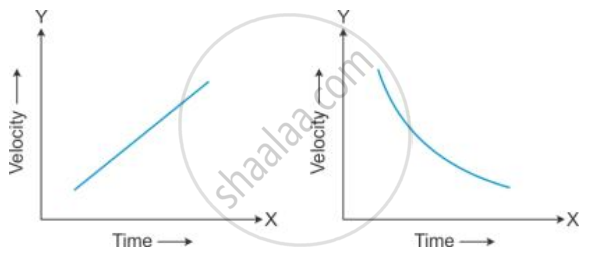Advertisements
Advertisements
प्रश्न
A car travels with uniform velocity of 25 m s-1 for 5 s. The brakes are then applied and the car is uniformly retarded and comes to rest in further 10 s. Find:
- The distance which the car travels before the brakes are applied,
- Retardation and
- The distance travelled by car after applying the brakes.
उत्तर
(i) As we know, Distance = Speed × time
Initial velocity (u) = 25 m s-1; Final velocity (v) = 0; time = 5 s
Substituting the values in the formula,
Distance = Speed × time
Distance = (25) × (5) m
∴ Distance = 125 m
(ii) Acceleration = `("Final velocity" - "Initial velocity")/"Time taken"`
∴ a = `("v" - "u")/"t"`
= `(0 - 25)/10` ms-2
= `(-5)/2` ms-2
= - 2.5 ms-2
∵ If v < u, then a is negative, and a is the retardation.
Therefore, retardation = 2.5 ms-2
(iii) After applying brakes, the time taken to come to stop = 10 s
Let S' be the distance travelled after applying the brakes.
Initial velocity u = 25 m/s
Final velocity v = 0
Using the third equation of motion,
∴ v2 - u2 = 2as
We get,
⇒ (0) 2 - (25)2 = 2 (- 2.5) (S')
⇒ 625 = 5(S')
⇒ `625/5` = S'
⇒ S' = 125 m
APPEARS IN
संबंधित प्रश्न
State the type of motion represented by the following sketches in Figures.

Give an example of each type of motion.
Explain the following concept in your own words with everyday examples:
Acceleration
Diagram is given below shows velocity – time graph of car P and Q, starting from the same place and in the same direction. Calculate the Acceleration of car Q between 2 s – 5 s.

A motor bike running at 5 ms−1, picks up a velocity of 30 ms−1 in 5s. Calculate
- acceleration
- distance covered during acceleration.
A body falls towards the earth. Does it have positive or negative acceleration?
State if the following situation is possible:
A body moving with constant acceleration but with Zero velocity.
The graph shows how the velocity of a scooter varies with time in 50 s.
Work out: Acceleration.
A car accelerates to a velocity of 30 m/s in 10 s and then decelerates for 20 s so that it stops. Draw a velocity-time graph to represent the motion and find:
The acceleration.
Exercise Problem.
A racing car has a uniform acceleration of 4 ms–2. What distance it covers in 10 s after the start?
What is the difference between uniform acceleration and non–uniform acceleration?
